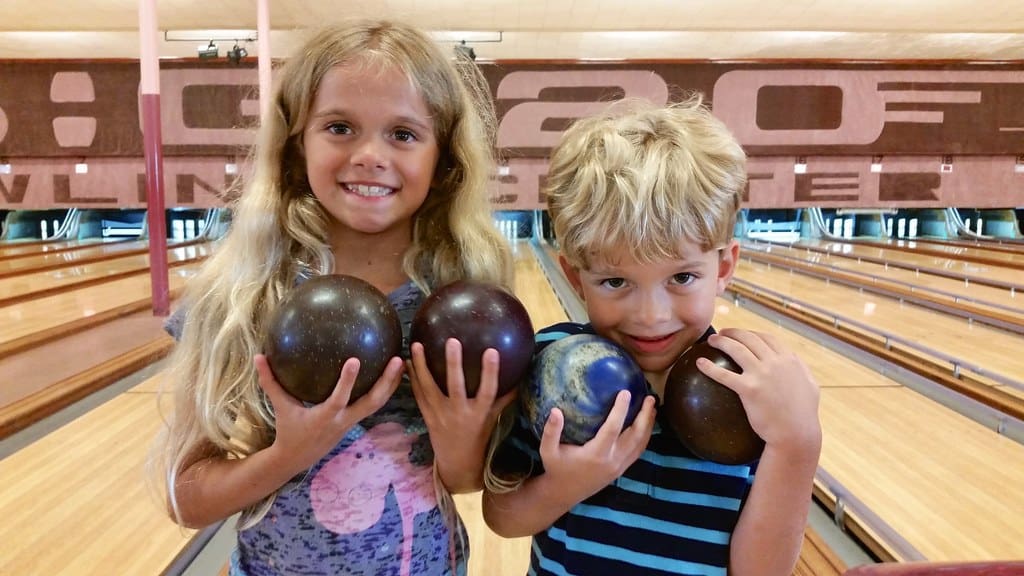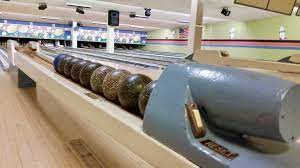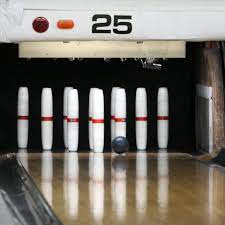In the very northeastern part of America, candlepin bowling reigns supreme. There is 10 pin bowling in the area, however, people there tend to lean towards candlepin bowling. So if you ever visit that part of America, people there may lean towards candlepin bowing being better than 10 pin.
I’m from Delaware and remember playing candlepin bowing during fun days in gym class, but it wasn’t really candlepin bowling like in the alleys. I like how the way the pins are made it harder to get a strike, unline in 10 pin, it’s pretty easy.
What are some differences between 10 pin bowling and candlepin bowling?
10 pin bowling and candlepin bowling both have the same game concept but there are a few differences that make the games not so similar to each other. For example, in candlepin bowling the ball size is only 4.5 inches in diameter whereas a 10 pin bowling ball is nearly double that at around 8.5 inches in diameter. Also, the weight of the balls is significantly different with a candlepin bowling ball being between 2 pounds 4 ounces and 2 pounds 7 ounces.

A regular 10 pin bowling ball is usually between 13-16 pounds which is around 7-8 times the weight of a candlepin bowling ball. Lastly, the balls in candlepin bowling do not have any finger holes because they are so small whereas, 10 pin bowling balls have finger holes. As regulated by the USBC and for grip and comfort.
Both types of bowling games have 10 frames per game however, in candlepin bowling you get three balls per frame instead of two because the pins are much harder to knockdown. Candlepins are also significantly thinner and taller than a normal bowling pin used in 10 pin bowling thus making them harder to knockdown. Another difference is that in candlepin bowling, the pins are not cleared away during the frame after each shot. They are left on the lane as “dead wood” which can make the game even harder if you have to try and dodge the pin on the lane while bowling your next shot.
Obviously, in 10 pin bowling, the pinsetter automatically clears the pins after each shot. Finally, the last difference is that the pinsetter is triggered manually with a reset button in candlepin bowling rather than automatically which is what happens when you’re playing 10 pin bowling.
The scoring systems in both games are more or less identical. Since there are three balls thrown in each frame when playing candlepin bowling, to score a strike you have to knock down every pin with your first bowl which is the same as 10 pin bowling. To get a spare you have to knock down all the pins with two bowls which is also the same as 10 pin bowling.
However, in candlepin bowling, you get one more ball to throw to help you knock down any remaining pins on the lane whereas, in 10 pin bowling you do not get a third throw unless it’s the last frame of the game. If you knock down the rest of your pins in the last throw you will get 10 points, one point for every pin knocked down.
How long is a candlepin bowling lane?
A candlepin bowling lane is almost identical to a 10 pin bowling lane. The lane approach is between 14-16 feet and then the lane is 41 inches wide, with a gutter each side of it. From the foul line to the head pin is 60 feet which is the same as a 10 pin bowling lane.
In 10 pin bowling, the lane is a level surface from the foul line to the pinsetter which is different from candlepin bowling. A candlepin bowling lane has a hard-surfaced pin plate where the pins are set up, with the pin plate depressed 11mm below the lane bed. The pin plate is can be made of metal, high-density plastic or synthetic material. Behind the pin plate area of the lane, there is a lowered pit area for the balls and knocked-down pins to fall into. A heavy rubber backstop that’s behind black curtains, catches flying pins and balls so that they drop into the pit.
On a candlepin bowling lane, there is a line 10 feet down from the foul line that is called the lob line. When bowling, the ball thrown must make contact with the lane on the bowler’s side of the lob line to ensure the ball is legal. If the ball makes contact after the line, then the ball will not count and any pins knocked down won’t count towards your score. There is also a third line centered 24 inches forward from the head pin spot which is called the dead pin line. This line defines the maximum limit a pin can roll forward when being knocked down and still be playable. If a pin passes this line, then it has to be removed from the lane before the bowler bowls their next ball.
Is candlepin bowling hard to learn/play?
Candlepin bowling is considered harder to play than 10 pin bowling. In 10 pin bowling, when a player has mastered the art of tossing the ball, that player can bowl a score of three hundred very often. This is because in 10 pin bowling, the speed and spin on the ball is more important than accuracy and positioning in terms of striking the pins.
However, in candlepin bowling, it doesn’t matter how hard or fast a ball is thrown, the angle and precision of the throw will have a greater determination on how successful you are when bowling. In candlepin bowling, you also don’t want to hook the ball. This is because you want to ball to be as accurate as you can to make sure it knocks down the pin successfully.

In 10 pin bowling, it is fairly easy for professionals to get a score of 300. In candlepin bowling, this has never been achieved. The highest record score in candlepin bowling is 245 which is a long way off of 300. This proves that candlepin bowling is a much harder game than 10 pin bowling. Smaller balls and smaller pins also play a massive part because it forces you to be more accurate which is the hardest technique to master in bowling. The ball is so small that it can pass through the gaps between some of the pins.
There are a few tips that should help you learn candlepin bowling faster. The first tip is to hold the ball in your fingertips rather than your palm. Holding the ball underarm with fingers spread apart and a firm grip should allow you to maintain control throughout the throw. A consistent grip should lead to consistent scoring.
Another tip is to only take a three-step run-up and slide on the last step. All your steps should be in sync to keep accuracy and focus on your target. The slide just enables you to use your momentum to out enough power onto the ball so it bowls straight. The final tip is to bowl hard, straight and from an angle. Most bowlers aim for the pocket between the headpin and either of the two pins behind it. Hooking the ball is ineffective in candlepin bowling. The ball should not be thrown from a high release point because this causes a bounce which reduces power and control.

